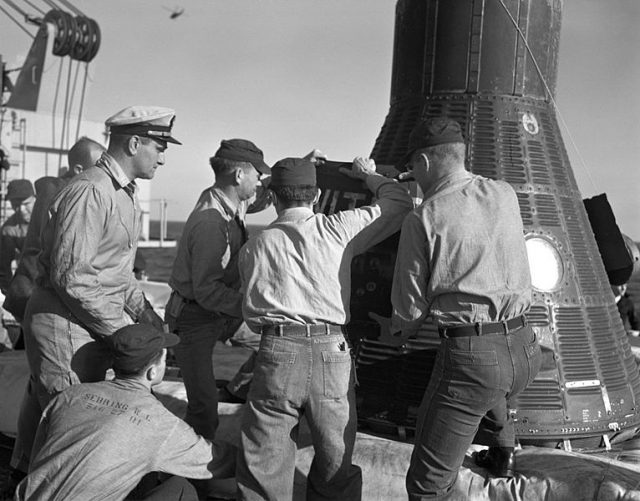On April 12, 1961, Russian pilot Yuri Gagarin became the first human who flew into space and safely returned to Earth. Less than a month later, on May 5, Alan Shepard became the first American in space. Although the space race between the Soviet Union and the United States started in the early 1940s, these two events marked the official beginning of the age of manned space exploration. Before the U.S.S.R. and the U.S. decided to send humans into space, they sent numerous animals in order to determine whether the technology of the time could safely shield living beings from the harsh and unpredictable conditions of space.
From the early 1940s to the early 1960s, animals such as fruit flies, mice, rabbits, and dogs were regularly sent into space. Until the early 1950s, all animals sent into space would die in space because no successful re-entry technology was developed until 1951. In 1951, two Russian dogs named Gypsy and Dezik were sent into space, just outside Earth’s atmosphere, and returned with the help of the newly developed re-entry technology.
Although they never entered Earth’s orbit, they were the first non-microbial lifeforms to survive a spaceflight. In 1960, the Russians succeeded in returning two dogs, Belka and Strelka, from Earth’s orbit. They immediately acquired international fame and one of Strelka’s puppies, Pushinka, was given as a present to Caroline Kennedy, the daughter of President John F. Kennedy.

However, the most significant spaceflight involving an animal occurred on January 31, 1961, merely two months before the Russians sent Gagarin into space, and three months before the Americans did the same thing. The animal involved was a five-year-old male chimpanzee known as Number 65. As a part of the Project Mercury, Number 65 was launched into space aboard a Mercury spacecraft which was propelled by a Mercury-Redstone 2 rocket. The spacecraft was equipped with a pressurized couch-capsule specially designed to secure the chimpanzee during the flight.

Although many doubted that Number 65 would return alive from his dangerous mission, his capsule safely landed in the Atlantic Ocean. After the capsule was opened, medical personnel determined that the chimpanzee suffered nothing but mild dehydration and a small bruise on his nose. He successfully survived a 16.5-minute flight and spent a total of six minutes in zero gravity. As soon as the chimpanzee was retrieved from the spacecraft, he was renamed “Ham,” after the Holloman Aerospace Medical Center in New Mexico where he was trained and prepared for his historic mission. Newspapers across the world named him “Ham the Astrochimp” and he immediately became an icon of progress. He was even featured on the cover of Life magazine.

Ham’s successful mission was extremely significant for several reasons. He was the first hominid who survived a spaceflight. Since the anatomical structure of a chimpanzee is similar to humans, his mission proved that humans would be able to survive spaceflights without any significant medical difficulties. Secondly, the human brain takes 5 milliseconds to respond to stimuli and the brain of a chimpanzee takes 7 milliseconds, only 2 milliseconds longer.
Because of this similar response time, the NASA researchers were able to monitor Ham’s brain during the flight and determine that it managed to perform the same tasks in space which he was taught to perform on Earth. Namely, while in zero gravity, he easily managed to pull several levers and click several flashing buttons. This convinced the NASA researchers that the human brain would work perfectly in space. Finally, Ham’s flight and his successful return proved that American technology was resilient and ready for manned spaceflights.

Before becoming a space-faring pioneer, Ham was a regular chimpanzee. He was born in the wilderness of French Cameroons, part of present-day Cameroon, and captured by trappers in 1957. He spent two years at a rare bird farm in Miami, Florida, and was then sold to the United States Air Force in 1959. At the Holloman Aerospace Medical Center, he was one of 40 chimpanzees who were candidates for the Project Mercury mission.
The veterinarians at the Center selected him as the most suitable candidate only a day before he was launched into space. After the flight, he lived at the National Zoo in Washington D.C. until 1977, when he was relocated to the North Carolina Zoo, where he joined a small group of older chimpanzees. He was 27 years old when he died. He was supposed to be stuffed, like the Russian pioneering dogs Belka and Strelka, and exhibited at the Smithsonian Museum, but a negative response stopped this from happening and some of his remains were buried at the National Space Hall of Fame in Alamogordo, New Mexico. His skeleton, which was extensively researched, is now held at the National Museum of Health and Medicine in Silver Spring, Maryland.
